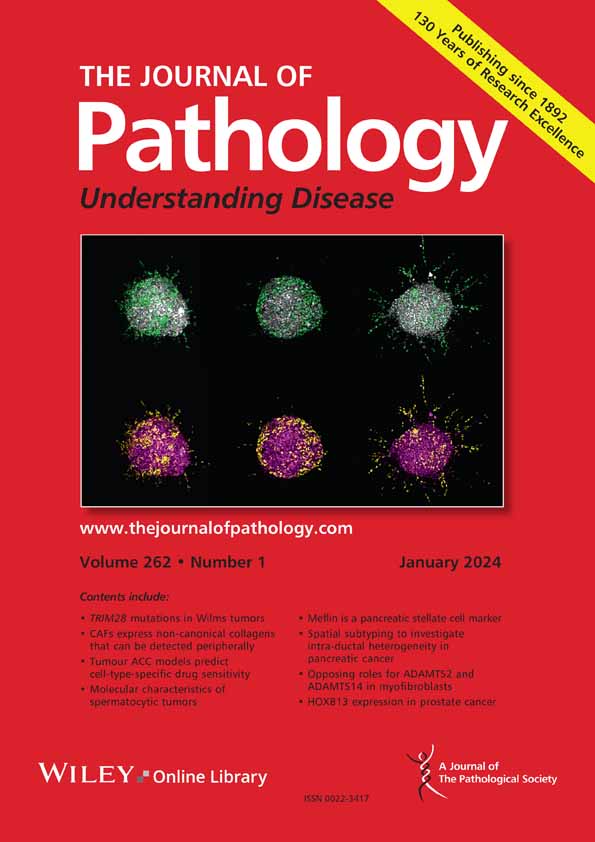下载PDF
{"title":"Intravenous iron treatment fuels chronic kidney disease-induced arterial media calcification in rats","authors":"Astrid Van den Branden, Britt Opdebeeck, Saar Adriaensen, Pieter Evenepoel, Tom Vanden Berghe, Anja Verhulst","doi":"10.1002/path.6375","DOIUrl":null,"url":null,"abstract":"<p>Arterial media calcification is a severe cardiovascular complication commonly manifesting in patients with chronic kidney disease (CKD). Patients with CKD frequently undergo intravenous iron therapy to address iron deficiency. Iron is suggested to be sequestered in vascular cells, potentially leading to oxidative (lipid) stress and cell death, which are recognized as key contributors to arterial calcification. The objective of this study was to investigate the effect of intravenous iron administration on CKD-induced arterial media calcification. Therefore, adenine-induced CKD rats were treated intravenously with iron and checked for arterial iron deposition and calcification, as well as for ferritin and lipid peroxidation markers. Additionally, arterial sections from patients with CKD who were dialysis dependent were analyzed for these parameters. This study showed that intravenous iron administration in CKD rats led to arterial iron deposition and a lipid peroxidation signature. CKD-induced arterial calcification was increased upon iron treatment and correlated with arterial iron accumulation and lipid peroxidation markers. Patients with CKD who were dialysis dependent showed arterial iron accumulation and elevated lipid peroxidation, but a direct correlation with arterial calcification was lacking. Taken together, iron treatment is suggested as a potential contributor to the calcification process, instead of being a predominant factor, thereby emphasizing the complexity of arterial calcification as a multifactorial disease. © 2024 The Author(s). <i>The Journal of Pathology</i> published by John Wiley & Sons Ltd on behalf of The Pathological Society of Great Britain and Ireland.</p>","PeriodicalId":232,"journal":{"name":"The Journal of Pathology","volume":"265 2","pages":"172-183"},"PeriodicalIF":5.6000,"publicationDate":"2024-11-29","publicationTypes":"Journal Article","fieldsOfStudy":null,"isOpenAccess":false,"openAccessPdf":"https://www.ncbi.nlm.nih.gov/pmc/articles/PMC11717497/pdf/","citationCount":"0","resultStr":null,"platform":"Semanticscholar","paperid":null,"PeriodicalName":"The Journal of Pathology","FirstCategoryId":"3","ListUrlMain":"https://onlinelibrary.wiley.com/doi/10.1002/path.6375","RegionNum":2,"RegionCategory":"医学","ArticlePicture":[],"TitleCN":null,"AbstractTextCN":null,"PMCID":null,"EPubDate":"","PubModel":"","JCR":"Q1","JCRName":"ONCOLOGY","Score":null,"Total":0}
引用次数: 0
引用
批量引用
Abstract
Arterial media calcification is a severe cardiovascular complication commonly manifesting in patients with chronic kidney disease (CKD). Patients with CKD frequently undergo intravenous iron therapy to address iron deficiency. Iron is suggested to be sequestered in vascular cells, potentially leading to oxidative (lipid) stress and cell death, which are recognized as key contributors to arterial calcification. The objective of this study was to investigate the effect of intravenous iron administration on CKD-induced arterial media calcification. Therefore, adenine-induced CKD rats were treated intravenously with iron and checked for arterial iron deposition and calcification, as well as for ferritin and lipid peroxidation markers. Additionally, arterial sections from patients with CKD who were dialysis dependent were analyzed for these parameters. This study showed that intravenous iron administration in CKD rats led to arterial iron deposition and a lipid peroxidation signature. CKD-induced arterial calcification was increased upon iron treatment and correlated with arterial iron accumulation and lipid peroxidation markers. Patients with CKD who were dialysis dependent showed arterial iron accumulation and elevated lipid peroxidation, but a direct correlation with arterial calcification was lacking. Taken together, iron treatment is suggested as a potential contributor to the calcification process, instead of being a predominant factor, thereby emphasizing the complexity of arterial calcification as a multifactorial disease. © 2024 The Author(s). The Journal of Pathology published by John Wiley & Sons Ltd on behalf of The Pathological Society of Great Britain and Ireland.
静脉铁治疗加速大鼠慢性肾脏疾病引起的动脉中膜钙化。
动脉中膜钙化是一种严重的心血管并发症,常见于慢性肾脏疾病(CKD)患者。慢性肾病患者经常接受静脉铁治疗来解决缺铁问题。铁被认为被隔离在血管细胞中,可能导致氧化(脂质)应激和细胞死亡,这被认为是动脉钙化的关键因素。本研究的目的是探讨静脉给铁对ckd诱导的动脉中膜钙化的影响。因此,腺嘌呤诱导的CKD大鼠静脉注射铁,并检查动脉铁沉积和钙化,以及铁蛋白和脂质过氧化标志物。此外,对依赖透析的CKD患者的动脉切片进行了这些参数的分析。本研究表明,CKD大鼠静脉给铁导致动脉铁沉积和脂质过氧化特征。铁处理后ckd诱导的动脉钙化增加,并与动脉铁积累和脂质过氧化标志物相关。依赖透析的CKD患者表现为动脉铁积累和脂质过氧化升高,但与动脉钙化缺乏直接相关性。综上所述,铁治疗被认为是钙化过程的潜在因素,而不是主要因素,从而强调动脉钙化作为一种多因素疾病的复杂性。©2024作者。《病理学杂志》由John Wiley & Sons Ltd代表大不列颠和爱尔兰病理学会出版。
本文章由计算机程序翻译,如有差异,请以英文原文为准。



